
Actively Engaged Together
Actively Engaged Together is designed for the students with low-proficiency, anxiety, and a limited repertoire of practice strategies. As such, it focuses on basic interpersonal communication skills through storytelling and an automatically scored 8-topic pen pal writing project using the Virtual Writing Tutor grammar checker. Students at this level enjoy exchanging messages each week with peers at the same college or at other schools.
Instead of giving these at-risk students more of what did not work for them in their high school English classes, grammar and vocabulary practice is story-based. Grammar and vocabulary are embedded in short narratives with illustrations, with a variety of oral practice strategy drills in each lesson to make new structures stick. Rather than try to memorize decontextualized rules and verb paradigms, students acquire the language directly as formulaic chunks in obligatory contexts.
Teaching and learning the social curriculum
When you talk to teachers who have taught college high beginners (100A), you might hear them say, “They are in the lowest proficiency level course for a reason.” Some students in 100A are immigrants and haven’t had much exposure to English. Other students have learning difficulties. But there are always a few students in 100A who do not seem understand some of the basic requirements of the job of being a student. In short, they haven’t learned the social curriculum.
As teachers, we have a choice: complain or teach. It’s easier to complain, “However did that kid graduate from high school? What are they teaching them there?” A better choice is to teach the students we get. Of course they need to learn the grammar, but they also need to learn the social curriculum. Here’s how Actively Engaged Together tackles the problem.
Peer dictation
Lesson 2 of Actively Engaged Together contains a reading on the impediments to learning the social curriculum, disciplinary removal, and research-based solutions. The reading is followed by a peer dictation activity and instructions. The instructions encourage students to do some pre-reading (looking ahead to see what’s coming), to choose a peer teacher on a rotating basis, to take turns, to use clarification questions, and the who should listen and write.
Student see contrasting pictures like the ones below, both with and without captions containing the simple present with negatives. The situations are presented without judgement, as observations only. There are 12 pairs of situations on 3 pages, allowing for every group member to be the peer teacher once and take dictation twice. By the end of the activity, each student will have transcribed 16 sentences and dictated 8.
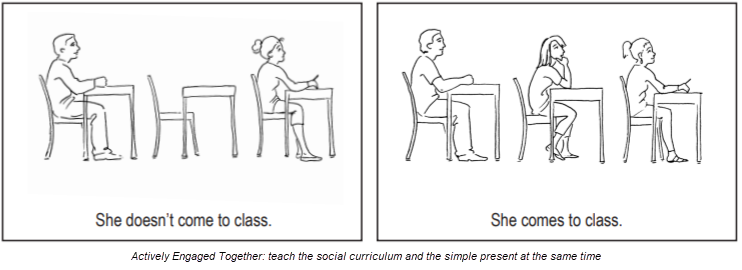

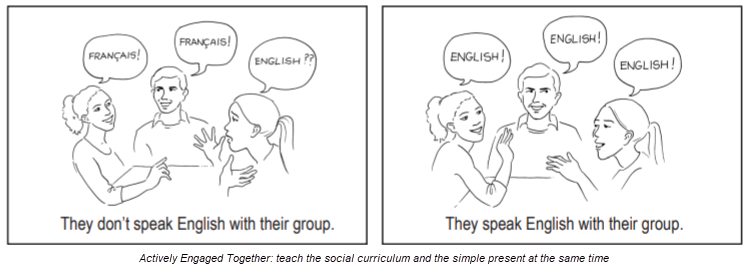
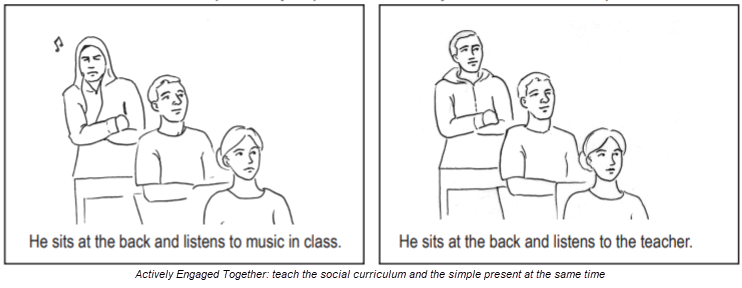
Short compositions
As a follow-up activity, students get practice expressing problems in English. Absenteeism and low engagement are often symptoms of problems imported from outside of the classroom. Articulating problems and expressing sympathy are important language functions that have to be learned by students with low-proficiency learners. The added benefit is that these expressions of distress and sympathy help to build a safe environment of sharing and caring.
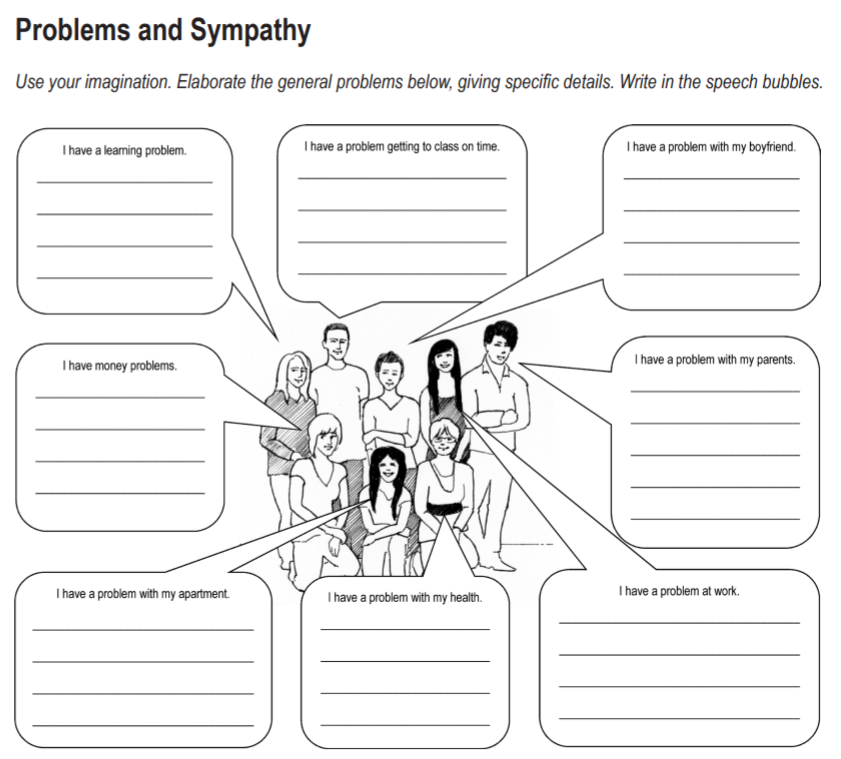
Grammar explanations and other thematically related think-pair-share activities follow in the same unit. Automatically evaluated speaking activities and exercises are available on Labodanglais.com to help reinforce the language and content of the lesson.
Speed review
Each subsequent unit begins with a speed review activity of language structures covered in the previous lesson. Speed review items can be found in the PowerPoint lessons available on Labodanglais.com. The teacher is free to use or modify these lessons (in contrast to the presentation materials from other publishers who share only secured PDFs). It looks like this and can used in whole or in part, depending on the available time.
Students are invited to predict their scores and self-evaluate at the end. Score prediction activities like this have been found to have the greatest effect on student performance of any classroom intervention as they amount to setting a performance goal while there is still time to do something about it (Hattie, 2009). In any case, students enjoy the gamification of review and accept the time pressure as a feature of gameplay.
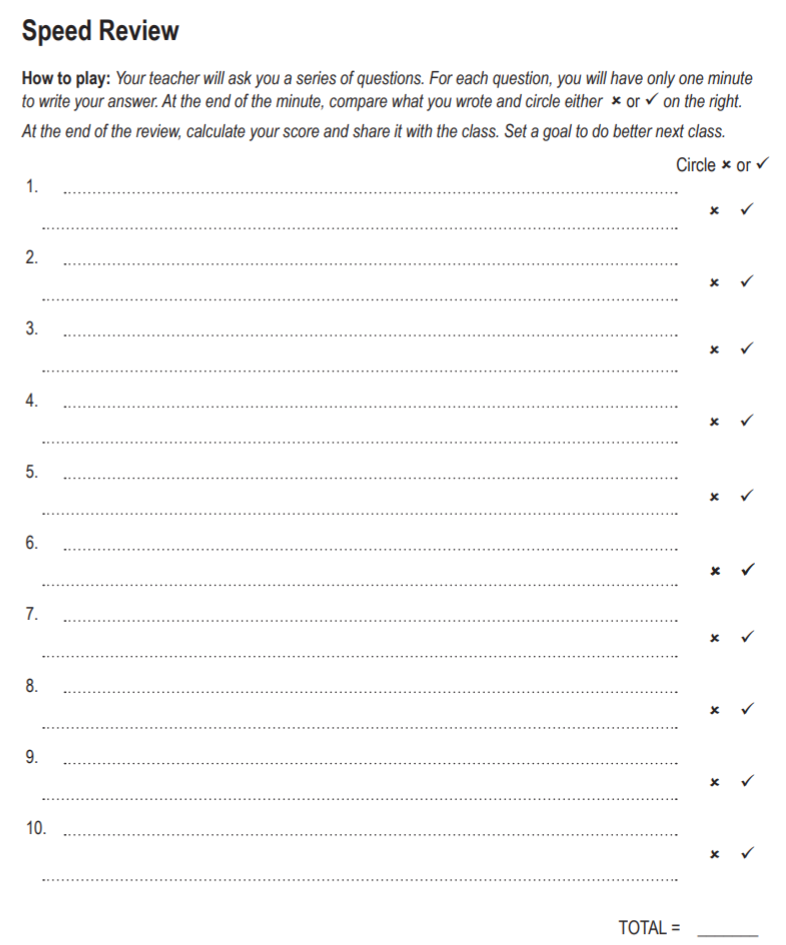
Oral practice strategies
Students get repeated training in five oral practice strategies. This type of strategy training is often left out of other textbooks. Perhaps the assumption is that students already know how to repeat and rehearse in a variety of ways. This assumption is clearly false. Students may have a vague awareness of building from the end, slow-faster-faster, five-finger drills, look up and say it, dialogue practice, and conversation practice, but these same students are too self-conscious or disengaged to actually apply these helpful strategies. Objectively, students’ mastery of these oral practice strategies is incomplete. Strategy use is everything.
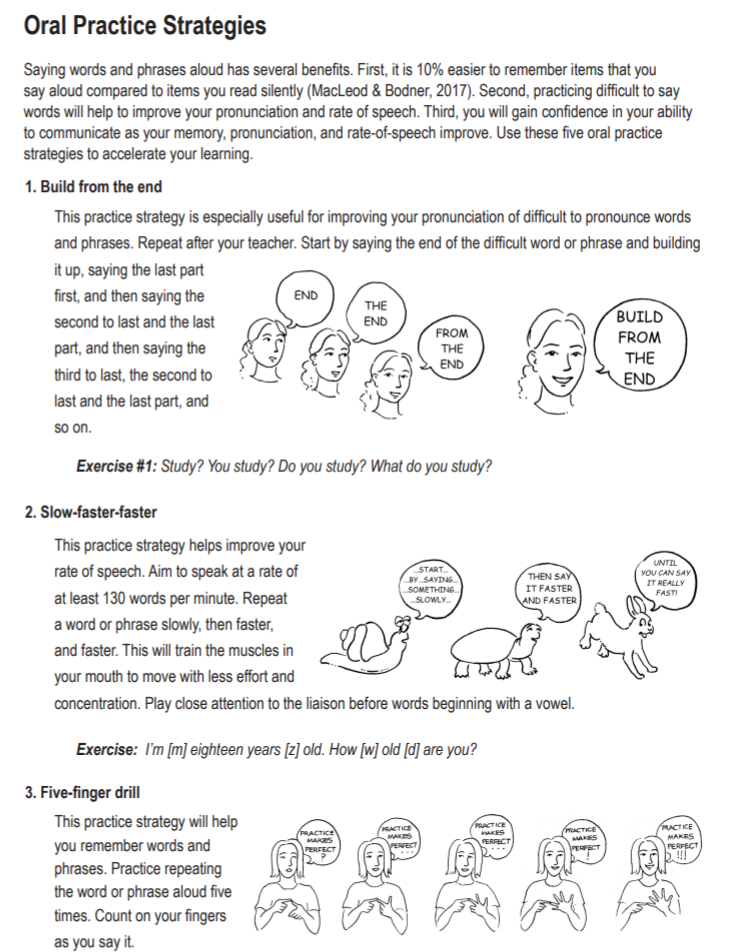
Automatically evaluated pen pal exchange
Every textbook in the Actively Engaged Series makes use of automated evaluation. Actively Engaged Together is no exception. However, with Actively Engaged Together, teachers have two choices. The first choice is the Pen Pal Exchange on Virtual Writing Tutor. There are a few steps required to create a pen pal exchange or you can ask me to set an exchange for your students. It only takes a few minutes either way.
The pedagogical advantage of the Virtual Writing Tutor’s pen pal exchange is that students converse with multiple pen pals to get extra meaningful practice using the target structures from the lessons in the textbook. Students get points automatically for writing longer messages using the target structures from the lesson and for eliminating their errors. Students also get points for replying to their pen pals’ messages.
Automated email evaluation
The second way to maximize form-focused writing practice using automated writing evaluation with Actively Engaged Together is to assign Fast Assignment email writing assignments within Labodanglais.com instead. With this method, students write their messages for a robot to score and correct. They get multiple opportunities for formative feedback, which maximizes revision and motivates students to revise more.
The advantage to using automated email evaluations using Fast Assignment on Labo is the automated scoring system is more sophisticated and gives more detailed feedback. The drawback is that the messages do not communicate with a other human beings unless the teacher gets students to print them out and exchange paper versions with classmates.
What’s the personality of Actively Engaged Together?
The pen pal writing assignments are practical. Students learn the vocabulary and grammar step-by-step to write meaningful messages to pen pals in another class. The readings focus on a variety of topics, including the social curriculum, pen pal writing, neighbourhoods, technology, bilingualism, meals in Canada, exercise, and low-carb diets and fasting. There is a lot of opportunity for students to engage in sharing and mutual support. Every week, students take turns to lead each other in the readings using reciprocal teaching.

